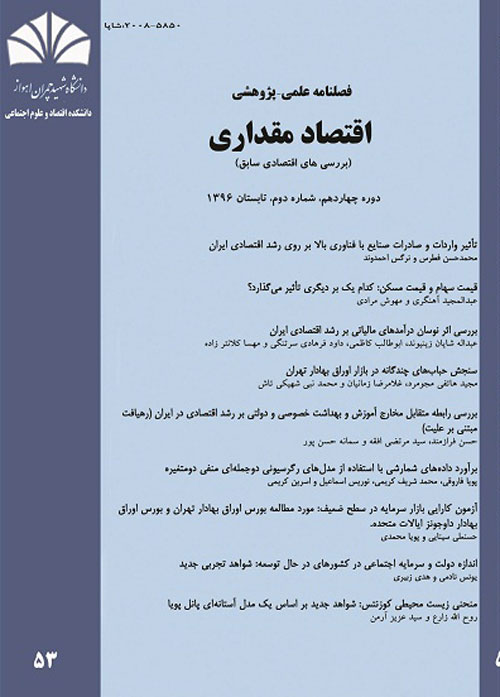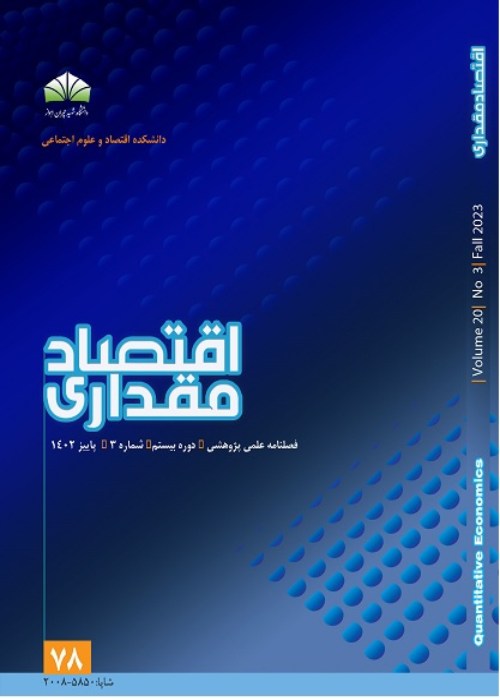فهرست مطالب

فصلنامه اقتصاد مقداری
سال چهاردهم شماره 2 (پیاپی 53، تابستان 1396)
- تاریخ انتشار: 1396/07/02
- تعداد عناوین: 9
-
-
Pages 1-24Nowadays, the importance of using modern high technology to industrialize developing countries that intend to inter in world economy is more and more evident. High-tech imported commodities as a proxy variable for spillover effect and technology transfer would the knowledge level in these countries. This process might increase the share of high tech industries in GDP and improve their exportation. In this study, using Romers endogenous growth model, the impact of import and export of low technology industries have been studied on economic growth of Iran for the period of 2003-2013. In this regard, seasonal data were used in an autoregressive distributed lag (ARDL) model to examine the relationship between variables. Results indicated a positive and significant impact of import and export of low technology industries on Irans economic growth. Also other variables i.e. capital stock, employment and research and development expenditures have had a positive and significant effects on Iranian economic growth.Keywords: Technology transfer, High- tech industries, Romer's endogenous growth model, autoregressive distributed lag, Iran
-
Pages 25-58Stocks and houses as two major assets which play important role in the balance sheet of Iranian households. Changes in two markets have a large influence on wealth and the general economy. The purpose of this study is to examine the relationship between stock and house prices over a thirty-year period using vector auto-regression (VAR). Using yearly data for the period from 1985 to 2013, we conducted a Granger-causality test and Impulse response functions (IRF). The causality test is performed with control variables and the results supply evidence on the bidirectional relationship between house price and stock price. Impulse response function is estimated in order to investigate the size and timing of the causality. The IRF concludes that, when the impulse is stock price, the every response of house price is most positive and the values fluctuate around the line zero at each time period.Keywords: House prices, Stock prices, VAR, Causality Impulse response functions Variance decomposition, Iran
-
Pages 59-84Economic growth has been concerned as a main economic goal by countries; therefore, understanding the factors Affecting it are important. Because of the extreme volatility in oil revenues in Iran, using of other income such as taxes is important in achieving the above objective. Due to fluctuations in fiscal policy, including taxes, the effect of these fluctuations on growth can help to achieve development goals in long-term. So this study examined the effect of fluctuations in tax revenues on economic growth for the period 1970-2013 using EGARCH-ARDL's model. The results showed that the fluctuation of tax revenues, however, has a negative coefficient, but in the short and long term has no significant effect on economic growth. But Statistics shows the tax revenues in the short and long term has a significant effect on growth.Keywords: Tax Revenues Fluctuations, economic growth, taxes, EGARCH-ARDL
-
Pages 85-110Not identifying of asset price bubbles and the type of them (single and multiple), cause collapsing effect on economy. New economic instrument, not only make possible the analysis of mildly explosive behavior of bubbles but also provide determination of origination and termination of bubbles. Therefore, the point of this study is detection of Tehran bourse and OTC stock price bubbles and date stamping of origination, explosion and complete deletion of bubbles in the period of 1389/01 to 1395/01. To this end, the study use total, industry, 50 firms and total OTC indexes. The results show that bourse and OTC markets have experienced 2 and 5 bubble periods respectively. The results also show that bourse and OTC markets were bubbling in 59% and 57% of sample period, respectively. Therefore, in this markets exist bubbles in more than half of the sample period that show large instability in the stock prices.Keywords: explosion bubble, Rolling Window ADF, Bourse, OTC
-
Pages 111-141Investment in education and health sector, as human capital, has an important role in economic growth and its enhancement in many countries. Lots of studies have been carried out in this field; however, the effect of simultaneous analysis of education and health, as well as the private and state sectors in economic growth of Iran has not been investigated. Thus, in the present study mutual relationship between private and state educational and health care expenditures with the economic growth of Iran from 1965 to 2014 has been surveyed. Therefore, in the present paper variables were tested by using Integration Adjusted Dickey Fuller test. Then for choosing appropriate causality test, the co-integration between variables was tested by ARDL method. Then, by using Granger, Toda and Yamamato causality tests, the two ways causal relationship between variables was assessed. First, findings showed a lack of long-run relationship between variables. Second, the results of causality tests indicated that there is no causal relationship between private and state educational expenditures with economic growth because educational system faces serious problems such as discordance between the educational system and needs of society and labor market. Also, the obtained results delineated that there is no causal relationship between private sector and state sector health care expenditures with economic growth.Keywords: Economic, Growth, Educational
-
Pages 143-166Negative binomial regression model (NBR) is a popular approach for modeling overdispersed count data with covariates. Several parameterizations have been performed for NBR, and the two well-known models, negative binomial-1 regression model (NBR-1) and negative binomial-2 regression model (NBR-2), have been applied. Another parameterization of NBR is negative binomial-P regression model (NBR-P), which has an additional parameter and the ability to nest both NBR-1 and NBR-2. This paper introduces several forms of bivariate negative binomial regression model (BNBR) which can be fitted to bivariate count data with covariates. The main advantages of having several forms of BNBR are that they are nested and allow likelihood ratio test to be performed for choosing the best model, they have flexible forms of mean-variance relationship, they can be fitted to bivariate count data with positive, zero or negative correlations, and they allow overdispersion of the two dependent variables. Applications of several forms of BNBR are illustrated on two sets of count data; Australian health care and Malaysian motor insurance.Keywords: bivariate Poisson regression model, bivariate negative binomial regression model, Correlation, overdispersion
-
Pages 167-192The present study investigated weak-form market information efficiency in Tehran security exchange (TSE) as an emerging market and in Dow Jones United States security exchange (DJUS) as a developed market based on random walk model. In each market, the random walk model was examined using daily and monthly returns of a set of indices. The results of the parametric and non-parametric tests indicated that the daily returns are not independent and identically distributed in TSE. Moreover, according to the results of the variance ratio test, a trending behavior in daily returns and mean-reversion behavior in monthly returns were observed. In DJUS, however, the daily returns were found to be independent and identically distributed and the results of variance ratio test did not confirm that the returns follow a particular pattern in this market.
-
Pages 193-213Social capital is one of the most important subjects in development economies. It has a crucial role in development process in developing countries. To the best of our knowledge, there is no study about the importance of government size on social capital, therefore the purpose of this paper is considering the relationship between government size and social capital in 109 developing countries during the 2008-2014 period. To do so, we have used a panel data method based on the model of Knack and Keefer (1997). Estimated Results of a fixed effect panel model indicate that there is a non-linear relationship between government size and social capital. When the government size is small (the government size is less than 26.17%), increasing government size has a significant positive impact on social capital, but when the government size is large (the government size is larger than 26.17%), government size has a significant negative impact on social capital. before this threshold level of government size, because of preparing safe environment, social and economic institutions, ensuring property rights, providing public goods and services, social securities, building schools and universities, etc., expanding government size lead to promote social capital. But after this threshold level, because of inefficient expenditure, corruption, crowding out private investments in social capital, expanding government size has the negative impact on social capital.
-
Pages 215-232This paper examines the non-linear relationship between CO2 emissions and economic development using an innovative dynamic panel threshold technique. The sample consists of 35 developed countries over the period 2003-2010. The empirical results indicate that there is a threshold effect in the relationship between economic growth and pollutant emissions as suggested by the environmental Kuznets curve (EKC). In particular, at the early stage of economic development below the estimated threshold value, more growth deteriorates the environmental problems. However, after this threshold value further growth serves as a solution to the environmental problems. Accordingly, promoting economic growth and becoming rich in the long run, is necessary to solve the environmental problems arising from greenhouse gas (GHG) emissions. In the short run and in the early stage of economic growth, focus on investments in environmentally friendly technology and on the use of renewable energy is necessary for mitigating the pollution effects of economic progress.


